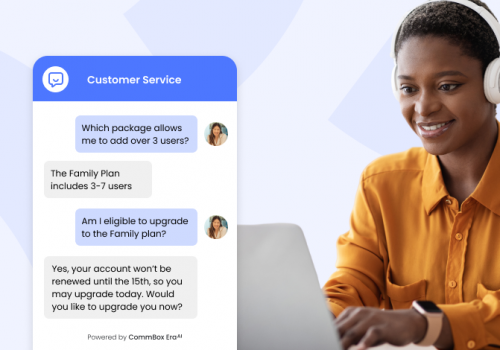Customer Service Becomes Marketing. Many companies are now making customer service part of their marketing budget. In the past, these two business functions would be siloed and operate totally independently of each other. However, in the digital age, there’s an increased focus on cohesiveness across the business.
Companies are starting to realize that no function should operate completely independently of another function. All parts of the business are working towards a common goal, so this should be reflected in how we work.
This is especially true for marketing and customer service functions. Your customer service is marketing. How you treat your customers and how they feel after interacting with your company will shape their future buying decisions. It will also shape your reputation not just for that customer, but for everyone that customer speaks to. There’s more to this, but at its most basic, this is why customer service is being included in marketing budgets all over the world.
Customer Service as a Marketing Strategy
You can use your customer service to great effect in your marketing. Customer service represents a core part of your business. Marketing might get new customers through the door, but it’s how you treat your customers once they’re in the room that matters. Customers care about what you can offer them in terms of experience. The market is saturated with a plethora of options for buying often very similar products. In the past, the price was everything. If you could guarantee the lowest price, then you were sure to have customers come flocking to your business. Today, consumers care increasingly about customer experience. They want to be appreciated, understood, and feel that they are valuable to your company.
If a consumer has never dealt with your company before, then they are unsure how you will deliver on customer experience. Do you solve issues quickly? Are you available to talk when I’m available? Is it easy to talk to someone who can help with a complex problem, should one arise? These are questions that will be running through the customer’s mind. You can’t prove you’re competent in all of these areas without dealing with the customer, but you can prove how you helped other customers. Let’s have a look at some ways you can use your customer service as marketing.
Reviews and Testimonials
We live in a review culture. It’s common for people to browse the reviews of a company before deciding on doing business with them. Some people even have rules like “I won’t buy from a company with less than 4 stars on Google”. Some people have a rule that they won’t buy from a company that doesn’t have many reviews, believing the reviews to be unreliable. One study found that 93% of consumers say that online reviews impact their buying decisions.
This doesn’t apply to all customers, but the majority of customers care deeply about reviews. This is why it’s so important to provide consistently high-quality customer service. If you frustrate a customer, it’s difficult to contain that frustration in the digital age. You may lose that customer’s business. You’ll lose business from their friends and family. And you’ll lose potential customers every time someone reads their negative review online.
Some amount of negative reviews are okay. You can’t please everyone all the time even when you try your best. Sometimes things go wrong, for example, a system outage might happen and render your phone lines out of action. This may generate some negative reviews and should be avoided by implementing preventative measures, but there’s not much that can be done in the moment to please angry customers.
However, just because some negative reviews are inevitable doesn’t mean you shouldn’t prioritize top-notch customer service. You want your negative reviews to be drowned out by lots of positive reviews.
Why Do Customers Write Reviews?
Customers write reviews because they trust the review system. They’ve read reviews in the past and those reviews have informed their buying decision. They want to do the same for other consumers. This is why good reviews work greatly in your favor. With other marketing materials like ads on websites or social media, the customer may be wary of your assertions. You say your company is great, but of course you would! It’s your company and you want to make money. In the eyes of customers, promoted advertisements aren’t as trustworthy as reviews by other customers.
According to a report by Trustpilot, a respected global consumer review site, these are the top three reasons that people write reviews:
- To help others make a better decision.
- To share an experience.
- To reward a company for good performance.
Interestingly, the top motivator is also different based on the consumer’s region. While consumers in the US were primarily motivated by sharing an experience, consumers in Europe were primarily motivated by positively impacting other consumer’s buying decisions.
The Trick to Getting Good Reviews
The same study found that consumers were much more likely to write a review after an emotional experience with the company. This emotion can be positive or negative. When the customer has an overwhelmingly positive experience with the company, they want to share it. When they have a very bad experience, they also want to share it. The key to getting good reviews is to focus on your customer’s emotions. Make them feel positive emotions by tailoring your customer service to be friendly and effective, and make the customer feel special.
Testimonials
Testimonials are written statements that attest to your company’s credibility. They work for much the same reason reviews work – the most persuasive messages come from satisfied customers and not marketers or sales reps.
Testimonials tend to be longer than reviews and have an exceptionally positive tone. You shouldn’t ask all your customers for testimonials. You should rarely ask a customer for a testimonial. If you have an overwhelmingly great experience with a customer where you have gone above and beyond and they are very grateful, then it would be a good idea to ask them.
Testimonials are a great addition to your website, sales page, blog, or marketing emails when used effectively. The testimonial must appear sincere otherwise it won’t be effective.

Create Buzz for Your Company with Fun and Quirky Customer Service Tactics
You can use customer service experiences as a way to springboard a viral marketing campaign. Of course, you want this to seem sincere and organic, rather than like you’re using the customer for your own gain.
You can do this by creating unforgettable experiences for your customers. People write reviews when they feel emotional about your company, so change that emotion. If a customer leaves a bad review, you can invite them back in an over the top way. Maybe offer them free food with their friends, pizza and a chat and some products, or whatever you can think of. The idea is to think outside the box and deliver something the customer isn’t expecting. This will likely mean they talk about it on social media (you’ve already learned they like to do that by writing a review), and this will improve your social reach.
Respond to Negative Feedback the Right Way
Customers are watching how you behave when you get a negative review. No one likes negative reviews; they tend to make us feel defensive and either want to defend ourselves or go on the attack. Both of these responses will make your company look back.
This is true on review sites, and also on social media. If a consumer posts a negative Tweet about your company, you shouldn’t reply telling them why they are wrong. It simply doesn’t work. You don’t convince the customer that you are right, and to any onlookers, you appear aggressive and fragile, which are not attractive traits in a person or a company.
Below are some tips on how to respond to negative reviews effectively:
- Apologize and empathize with the customer. People want to feel validated, so this should be a priority in your response. You need to acknowledge why they are upset and apologize for disappointing them.
- Offer to move the conversation offline. Your response should be apologetic and polite, and also offer a way for the customer to contact you on a different platform. This serves two purposes. Firstly, you can have a more intimate conversation with the customer about their expectations and offer a personalized solution. Secondly, if the customer continues to become irate, at least it’s no longer public.
- Don’t be too wordy with your reply. Responses to criticism are hard to get right. Sometimes 99% of the content in your response is perfect, but one line might annoy the customer. When this happens, they will forget all of the positive parts and be taken right back to why they were annoyed in the first place. To avoid this, try to keep your response short and concise.
How the Customer Service and Marketing Teams Can Work Together
Create a Joint Budget
Below we’re going to list all the ways you can bring the marketing and customer service teams together to take your customer experience to the next level. If each time is arguing about whose budget certain projects need to come out of, then they won’t work effectively. It makes more sense to unify the budgets into one and allow for a freer way of working.
New Marketing Ideas
Successful marketing starts and ends with understanding your customers. You might have a great idea for a campaign, but if you aren’t close to your customers, the marketing material might not land how you want it to. Similarly, you might be struggling to come up with ideas. What do your customers want? What’s their primary focus? What do they love about your company?
This is where the customer service team comes in. They talk to your customers every day. They know your customers better than anyone else in the business. There should be a flow and exchange of ideas between the two teams to create effective marketing.

Omnichannel Platforms – Use the Right Tools!
For teams to work effectively together, they need to be supported by the right tools. If team members are working across several systems, there’s a very real risk that information will be lost or duplicated with errors. CommBox’s omnichannel platform allows for highly effective and productive working by giving employees all the tools they need in one place. This significantly reduces time lost in switching between systems, correcting errors, training, and more. Employees can get on with their job without any hassle.
Create Buyer Personas
The marketing team can work with the customer service team to create buyer personas. These are fictional representations of your customers. The idea here is to get into the mindset of your customer. What kind of person buys your product? Will other people like them be interested in buying too? How does this person want to be communicated with?
Handling Expectations
Customers in the digital age have high expectations. You should strive to offer as much as possible to set yourself apart from the competition and provide a grade A customer experience. However, it’s essential that you only promise things you can deliver.
Marketing material showcases the best things about your company and what you offer. Marketers should be talking to the customer service team to determine whether those expectations have been met.
Some customers may have found the marketing misleading. Maybe they thought they were getting one thing, but they actually got something different. The customer service team will be closer to these inconsistencies than anyone else in the business.
Consistent Voice
Your company must maintain a consistent voice. This means that the tone and message of the marketing must be reflected in customer service interactions. There’s little point in the marketing material saying one thing and customer service saying a completely different thing.
The message must be unified. Marketers bring the customers in, but it’s for customer service to deal with these customers. That’s why both teams must understand the messaging used and have a unified response.
A consistent voice is also maintained through the use of a more cohesive working environment. The closer the teams are and the easier they find it to work together, the more unified the message will be. This is another great reason to opt for an omnichannel approach.















